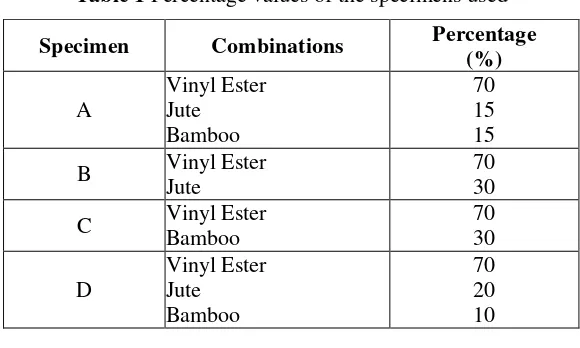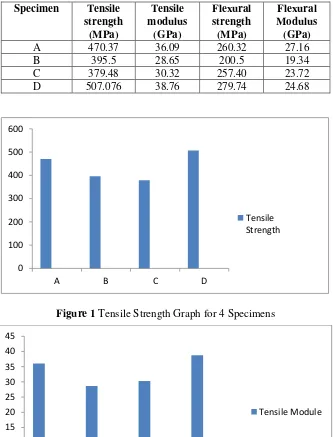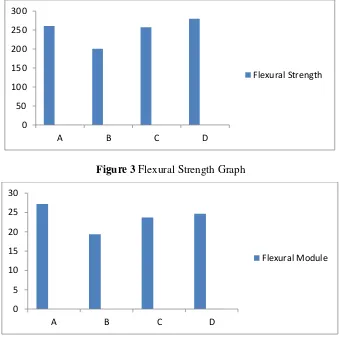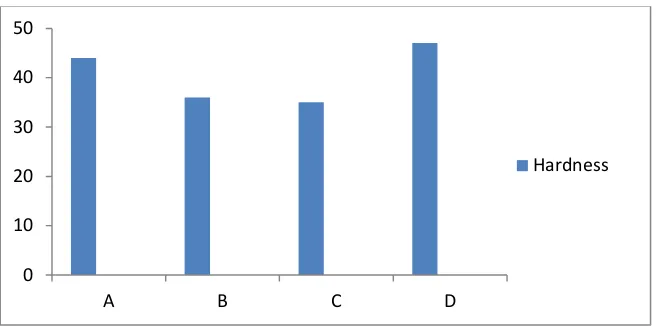Available online at http://www.iaeme.com/IJMET/issues.asp?JType=IJMET&VType=8&IType=10 ISSN Print: 0976-6340 and ISSN Online: 0976-6359
© IAEME Publication Scopus Indexed
ANALYSIS OF MECHANICAL PROPERTIES OF
HYBRID BAMBOO/JUTE FIBERS REINFORCED
& VINYL ESTER COMPOSITE MATERIAL
Bino Prince Raja D
Research Scholar, Department of Aeronautical Engineering, Noorul Islam Centre for Higher Education, Kumaracoil, India
Stanly Jones Retnam B
Associate Professor, Department of Automobile Engineering, Noorul Islam Centre for Higher Education, Kumaracoil, India
Mohini Shukla
U.G. Scholar, Department of Aeronautical Engineering, SCT Institute of Technology, Bangalore, India
ABSTRACT
Polymer matrix composites (PMC) materials had acquired much attention in the field of Aeronautics over the recent decades as high strength-lightweight materials. These abundantly available fibres are embedded with a light polymer matrix resulting in a high strength and light weight fibre reinforced polymer composites. In this paper, we have investigated the mechanical behaviour of fabricated composite materials with four different combinations consists of Bamboo/Jute as a reinforcing agents and vinyl ester as a polymer matrix. Several tests has been carried out to enhance the properties such as tensile strength, flexural strength, hardness and impact strength and it was compared for different orientations (±90º). It is reported that the hybridization of the constituents with 20% of Jute, 10% of Bamboo shows better Tensile strength, Flexural strength and Hardness number than other combinations examined.
Key words: Tensile, Flexural, Impact, Bi-directional, Hardness, Bamboo, Jute, Vinyl Ester.
Cite this Article: Bino Prince Raja D, Stanly Jones Retnam B and Mohini Shukla, Analysis of Mechanical Properties of Hybrid Bamboo/Jute Fibers Reinforced & Vinyl Ester Composite Material, International Journal of Mechanical Engineering and Technology 8(10), 2017, pp. 318–328.
http://www.iaeme.com/IJMET/issues.asp?JType=IJMET&VType=8&IType=10
1. INTRODUCTION
Composite Material
properties of reinforcement. Mostly fibers which have advantages such as low density, high strength-to-weight ratio and high stiffness are used as a reinforcing phase. The properties of matrix along the direction of the reinforcement orientation together with the reinforcement properties show high performance in the mechanical properties of the composites. Hence the finished product has an overall structure versatility. The load and stresses always transfer from matrix to the reinforcement. Natural fibers (bamboo/jute) and polymer matrix (vinyl ester polymer) are the considered ingredients for the present analysis. The term natural fibers is defined as the fibers which are extracted from the natural resources such as plants, trees, animals etc. They are initially utilized in the commercial industries in the field of automobiles
and household tools… etc. [2]. Natural fibers are recyclable, less expensive and resistive to breakage or damage, strong and low weight constituents [3]. Mechanical properties of the composite materials made up of quite a few of the fibers such as kenaf, hemp, flax, bamboo and jute are examined numerously by several authors [4,5].For 45o Orientation of hybrid FRP (mixture of polyester, Bamboo and E-glass) yielded better results of mechanical properties is been analyzed and reported [10]. Polymer matrices have light weight, high stiffness, and high strength. It also provide good corrosion resistance. The role of hybridization in improving the mechanical properties of tensile, flexural and shear strength of the composite materials are proven [8].
Short Bamboo/jute fibers are predominantly available resources in nature. Due to high strength along a longitudinal axis and low strength towards the transversal axis, bamboo fiber is also called as natural glass fiber and they are orthotropic in nature. The tensile properties of bamboo based polymer composites are investigated by Kazuya et.al [6]and evaluated that compared to matrix, the tensile and modulus is increased by 15% and 30%, respectively. The ability of natural fibers such as jute, sisal, hemp, coir and banana to form a composite were also studied and proved [7]. The comparisons of numerous polymer matrix composites which are reinforced with the fibers for their mechanical performance [9]. Jute fibers have several properties such as high tenacity, bulkiness, heat insulation property and low thermal conductivity and they are eco-friendly because of their high degradability. Vinyl Ester is one kind of thermoset polymer which is brittle in nature and contains carbon oxygen bond. Generally, the fabrication of composites is done by different methods by changing the matrix for reinforcement. For PMC, we use two kinds of the fabrication process. Open Mould Process and Closed Mould Process.
In this experiment, we have done fabrication of composites by the hand lay-up process (a kind of open mould process) in bi-directional orientation with short fibres. Tensile testing and flexural testing for the material are carried out by Universal Testing Machine (UTM).Impact test has been done by Charpy testing machine. From the stress and strain value, the values of flexural strength and flexural modulus are derived. Rockwell Hardness test is completed with the help of ball indentor.
2. PREPARATION OF MATERIALS
Table 1 Percentage values of the specimens used
Specimen Combinations Percentage
(%)
3. FABRICATION PROCESS AND METHODOLOGY
The hybrid composite materials made up of bamboo, jute and vinyl ester will have weaves in bi-directional. The bidirectional orientation is proved to produce more strength than the unidirectional orientation. Hybrid composite will possess superior characteristics against individual composite because natural fibre has high level of weight reduction comparing to the glass fibre. Here, we considered 4 combinations aligning with bamboo, jute and vinyl ester. Below all 4 combinations are shown with a percentage value of every material in composite material with bi-directional orientations.
The fabrication is processed by the above mentioned Hand Lay Up process. It is a very old method to fabricate the composite material, it is less expensive and require minimum amount of tooling. In hand lay-up process, initially, the gel coat is applied on the mould using a spray gun, since the composite material which we are fabricating can be detached from the mould effortlessly. After curing the gel, the reinforcements are placed by hand in a mold as per the required percentage in a different orientation. Then the laminating resin is applied by pouring and by using the roller the laminate is consolidated and the entrapped air is removed from the combination. We have made four specimens with different percentages of the bamboo, jute and vinyl ester. We have done all the experiments to get the values of tensile strength, flexural strength, hardness and impact test on the specimen so that the points of failure of the material, elongation of material and impact resistance of the material can be determined. All the manufacturing and fabrication are done according to the ASTM standard.
Tensile strength and tensile modulus are determined after the point of failure. Flexural strength and flexural modulus are also explored by the values of stress, strain, bending stress etc. Rockwell hardness test material is presented on the platform and by ball indentor, the force is been applied on it and the relative hardness of the material was indicated by the dial gauge. There is only one notch for Charpy test and the impact is not applicable at an angle.
4. RESULTS AND DISCUSSIONS
Composite Material
Table 2 Mechanical properties of the combined specimen Specimen Tensile
strength (MPa)
Tensile modulus
(GPa)
Flexural strength (MPa)
Flexural Modulus (GPa)
A 470.37 36.09 260.32 27.16
B 395.5 28.65 200.5 19.34
C 379.48 30.32 257.40 23.72
D 507.076 38.76 279.74 24.68
Figure 1 Tensile Strength Graph for 4 Specimens
Figure 2 Tensile Modulus Graph
Figures 1 and 2 shows that the hybrid specimen D which contains short Jute fibres in greater proportion than Bamboo indicated a high resistance to beak compared to the other orientations. Along with it the modulus of rupture or flexural strength is shown to be promising for the hybridization of the composite D which implies that the material has higher ability to resist deformation under load. Bending modulus or a flexural modulus exposes the tendency for a material to bend is high for the hybrid composite specimen A with the same fraction of Jute and Bamboo.
0 100 200 300 400 500 600
A B C D
Tensile Strength
0 5 10 15 20 25 30 35 40 45
A B C D
Figure 3 Flexural Strength Graph
Figure 4 Flexural Modulus Graph
Rigidity of the material is evaluated as hardness using the Rockwell hardness tester and the related Rockwell hardness numbers are determined. The impact toughness of the material is found by Charpy Impact test.
Table 3 Values of hardness and impact strength 0
50 100 150 200 250 300
A B C D
Flexural Strength
0 5 10 15 20 25 30
A B C D
Flexural Module
0 1 2 3 4 5 6 7
A B C D
Impact Specimen Rockwell Hardness Number Impact Strength (J)
A 44 2.57
B 36 3.83
C 35 4.06
Composite Material
Figure 6 Hardness of the composites
Observations of the Figures 5 and 6 results that the hardness and impact strength of the composite D is greater show its ability to withstand considerable loads.
5. CONCLUSIONS
In this analysis of four combination of the Bamboo/Jute fibre reinforced with the vinyl ester matrix yields the following conclusions:
The structural strength exposed by Jute is greater than the Bamboo and thus the accountability of that fibre is more.
From the analysis, it is observed that the hybrid specimen D shows high tensile strength of 507.76 MPa and flexural strength of 270.74 MPa compared to other combinations.
Also, The Specimen A consists each of Jute and Bamboo as15% resulted in higher flexural modulus of 24.68 GPa.
Hardness test and impact test on the specimen D reportedly exposed high values in hardness number and impact strength.
By the above results, it is suggested that this composite can be used in the commercial aircrafts for reducing the overall weight of the aircraft and to satisfy the necessary structural strength requirements.
The overall value of strength of the PMC material performs better mechanical properties and sustainability over the individual forms of reinforcement and matrix.
REFERENCES
[1] D. Bino Prince Raja, Stanly Jones Retnam B, M. Ramachnadran, “Analysis of mechanical properties of glass and carbon fiber reinforced carbon materials”, ISSN 0973-4562 Vol 10, No. 11 (2015)
[2] Wallenberger F.T and Weston N., 2004, “Natural Fibers, Plastics and Composites Natural” Materials Source Book from C.H.IP.S. Texas.
[3] Bledzki AK, Gassan J, 1999, Composite reinforced with cellulose base fibers, Program PolymSci; 24, 224-74.
[4] Satyanarayana K. G., Sukumaran K., Mukherjee P. S., Pavithran C. and Pillai. S. G. K. 1990 “Natural Fiber – Polymer Composites”, J cement and concrete Composites, 12(2), pp. 117-136.
0 10 20 30 40 50
A B C D
[5] Satyanarayana K. G., Sukumaran K., Kulkarni A. G., Pillai S. G. K., and Rohatgi P. K., 1986, “Fabrication and Properties of Natural Fiber-Reinforced Polyester Composites”, Journal of. Composites 17(4), pp. 329-333.
[6] Kazuya Okubo, Toru Fujii and Yuzo Yamamoto, 2004, Development of Bamboo based Polymer composites and their mechanical properties, Composites Part A: Applied Science and Manufacturing, 35(3), 377-383.
[7] Thi-Thu-Loan Doan, Shang-Lin Gao and Edith Mader, 2006, Jute/polypropylene composites I. Effect of matrixodification Composites Science and Technology, 66, 7-8, 952-963.
[8] Herrera-Franco, PJ, A Valadez-Gonza’lez, 2005, A study of the mechanical properties of short natural fiber reinforced composites. Composites B; 36(8), 597-608.
[9] Zhishen Wua., XinWanga, Kentaro Iwashita, Takeshi Sasaki, Yasumasa Hamaguchi 2010, 66. “Tensile fatigue behaviour of FRP and hybrid FRP sheets”, Composites: Part B 41 396-402.
[10] Stanley Jones Retnam B., Sivaprakash M., Edwin Raja Dhas J, “Effect of fiber orientation on mechanical properties of Nano FRP composites”, 2013, International Journal on Design and Manufacturing Technologies, vol. 7, No. 2.
[11] Sreenivasulu S., Dr. A. Chennakesava Reddy, “Mechanical properties evaluation of Bamboo fiber reinforced composite materials”, 2014, International journal of engineering research, vol. No. 3.,pp: 187-194.
[12] Kannan Rassiah, M. M. H. Megat Ahmad,”A review on mechanical properties of Bamboo fiber reinforced polymer composite”, Australian journal of basic and applied sciences, 7(8): 247-253, 2013.
[13] Nanda Kumar. D, Raghul. K. S. Jeyakumar. R,” Study on mechanical behaviour of Bamboo fiber reinforced with polymer matrix composite: A Review”, IJIRSET, 2016, Vol. 5.
[14] Athijayamani, A., M. Thiruchitrambalam, V. Manikandan and B. Palanivel, 2010. Mechanical properties of Natural Fibers reinforced Polyester hybrid composite, International journal of plastic technology, 14: 104-116.
[15] Bahari, S. A, M. Ahmad, K. Nordin and M. A. Jamaludin, 2007, “Tensile mechanics of Bamboo strips CP1217 International Conference on Advanced Materials and Nano Technology.
[16] S. Kavitha and Dr. T. Felix Kala, Effect of Bamboo Fiber in Self Compacting Concrete Partially Replacing Cement with GGBS and Alccofine. International Journal of Civil Engineering and Technology , 8(3), 2017, pp. 158 –166
[17] Kavitha. S and T. Felix Kala, Bamboo Fibre Analysis by Scanning Electron Microscope Study. International Journal of Civil Engineering and Technology, 7(4), 2016, pp.234– 241.



